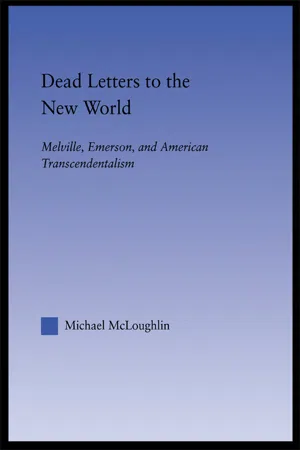
Dead Letters to the New World
Melville, Emerson, and American Transcendentalism
- 240 pages
- English
- ePUB (mobile friendly)
- Available on iOS & Android
About This Book
This book contextualises and details Herman Melville's artistic career and outlines the relationship between Melville and Ralph Waldo Emerson. Michael McLoughlin divides Melville's professional career as a novelist into two major phases corresponding to the growth and shift in his art. In the developmental phase, from 1845 to 1850, Melville wrote his five Transcendental novels of the sea, in which he defended self-reliance, attacked conformity, and learned to employ Transcendental symbols of increasing complexity. This phase culminates in Moby-Dick, with its remarkable matching of Transcendental idealism with tragic drama, influenced by Hawthorne. After 1851, Melville endeavoured to find new ways to express himself and to re-envision human experience philosophically. In this period of transition, Melville wrote anti-Transcendental fiction attacking self-reliance as well as conformity and substituting fatalism for Emersonian optimism. According to McLoughlin, Moby-Dick represents an important transitional moment in Herman Melville's art, dramatically altering tendencies inherent in the novels from Typee onward; in contrast to Melville's blithely exciting and largely optimistic first six novels of the sea, Melville's later works - beginning with his pivotal epic Moby-Dick - assume a much darker and increasingly anti-Transcendental philosophical position.
Frequently asked questions
Information
Table of contents
- Cover Page
- Title Page
- Copyright Page
- Acknowledgments
- Introduction
- Chapter One Correspondent Colorings: Emerson and Melville
- Chapter Two Shadows in Eden: American Transcendentalism and Its Discontents
- Chapter Three Deeper Shadows to Come: The Transcendental Underpinnings of Melville’s Early Works
- Chapter Four Defying Nature: Moby-Dick and the Limits of Emersonian Individualism
- Chapter Five A Hell-Fired Rural Bowl of Milk: Melville’s Pierre and Transcendental Rebellion
- Chapter Six Naked Nature aboard the San Dominick: “Benito Cereno,” Emerson, and the Gothic
- Chapter Seven The Endless, Winding Way: Melville’s Engagement with Emerson in The Whale’s Wake
- Appendix The Emerson-Melville Relationship: An Annotated Secondary Bibliography
- Notes
- Bibliography